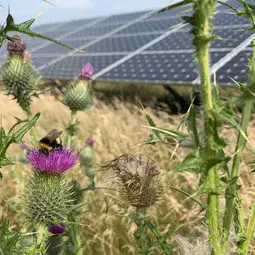Fields of solar panels could serve as havens for butterflies and bumblebees
23 May 2022
MUNICH — As communities explore sources of renewable energy, many are building solar parks: rows and rows of solar panels that soak up energy from the sun. While such efforts reduce greenhouse gas emissions, solar parks require large tracts of land. And so a future that relies on solar power will see significant changes to landscapes.
Within these changes, Hollie Blaydes sees an opportunity. Blaydes, a PhD student studying ecology at Lancaster University in the United Kingdom, envisions a way where land used for solar power production also creates habitats for bees, butterflies, and other pollinators.
“Creating pollinator habitats within solar parks could be a win-win,” Blaydes says. “As long as the vegetation does not shade the panels, we could produce the energy we need whilst boosting biodiversity.” Blaydes has spent the last two years studying how solar parks can be transformed into havens for pollinators. She will present the latest on her team’s research this week at the European Geosciences Union (EGU) General Assembly 2022.
Mounted solar panels disturb very little of the ground, making them ideal places for pollinator habitats like wildflower meadows, Blaydes explains. But several questions remain: Would such meadows attract bees and butterflies? What factors in surrounding landscapes influence whether pollinators make solar parks their homes? And what management decisions within the parks govern whether these pollinators stay?
To learn more, Blaydes and her team based at Lancaster University and the U.K.’s University of Reading surveyed bumblebees, butterflies and flowering plants last year between July and September across 15 solar parks in England. They also examined nearby landscapes to determine how connected these parks are to other habitats suitable for pollinators. The team found more bees and butterflies at solar parks with more species of flowering plants. They also found that solar parks less connected to other tracts of land with flowering plants became an oasis for pollinators searching for viable habitats.
The findings offer hope for pollinators, whose populations worldwide are shrinking. “Flowering plants are vital for bees and butterflies — they serve as sources of nectar and pollen,” Blaydes says. “Growing wildflower meadows helps to tackle pollinator declines, transforming solar parks into pollinator refuges.” Such transformations, she adds, could be a boon to farms close to solar parks that rely on pollinators like bees and butterflies to produce their crops. So, one thing to consider, Blaydes says, is management of the parks — mowing less often or less intensively will allow vegetation to grow and flowers to establish, potentially attracting more bees and butterflies.
“From afar, a solar park looks like a sea of lifeless industrial panels oversailing the landscape.” Blaydes says. “But, when you get up close, it can teem with life when managed appropriately. We’ve found that when vegetation grows and flowers take root, pollinators such as bumblebees and butterflies can be both abundant and diverse.”
More information
When reporting on this story, please mention the EGU General Assembly 2022, which is taking place from 23-27 May 2022. This paper will be presented in session ERE1.7 on Tuesday, 24 May, 09:10–09:17 CEST. If reporting online, please include a link to the abstract: https://meetingorganizer.copernicus.org/EGU22/EGU22-2180.html.
Press release text by Mohi Kumar.
Contact
Gillian D’Souza
EGU Media and Communications Officer
Munich, Germany
media@egu.eu

